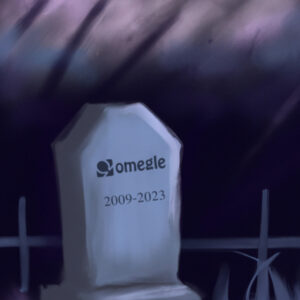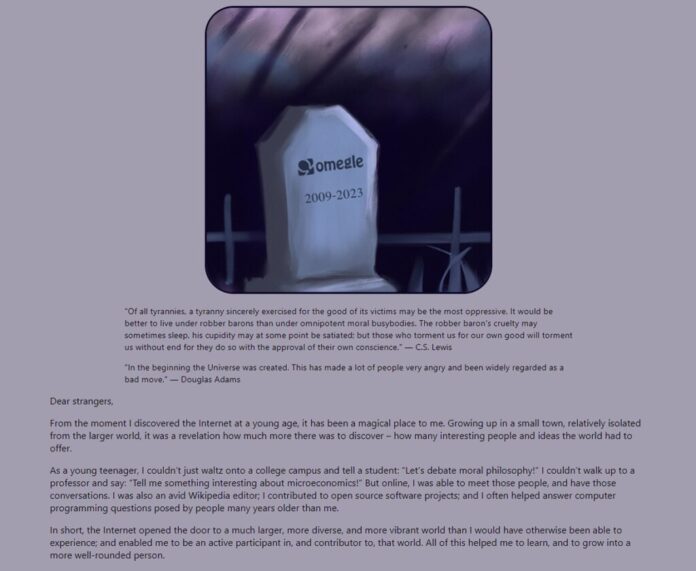
In November 2023, the popular website Omegle was shut down. Millions of online conversations across the globe cut short. Instead of meeting a new random stranger, all of Omegle’s users met a farewell letter. Some may consider it an apology, but others see an argument on morality and accountability.
I believe that the history of the site in its entirety, including its beginnings and its shutdown, reflect the origins and ultimate consequences of rash thinking.
What is Omegle?

On March 25, 2009, Leif K-Brooks created a website called Omegle. With its slogan “Talk to Strangers,” Omegle was an online chat service that would pair two strangers together from across the world to meet and chat anonymously on video, all at the click of a button on screen. It would allow its users to take preferences into account, like their country or shared interests. Omegle allowed teenagers at least 13 years old to access the site. More recently, the staff changed this rule in 2022 and the age restriction shifted to 18 years old and older. Although it was possible to get banned by admins on Omegle, this rule was rarely enforced. The website required no registration or account, with its URL (the address of a web page) being accessible to anyone on the internet.
On November 8, 2023, all users on the platform were met with an image of a tombstone with “Omegle 2009-2023” inscribed on it, along with a 1,848 word parting note from K-Brooks. Everyone understood that after 14 years of running as an icon of the internet, the site finally shut down for good. This closure of the website may have been a surprise for some, but many others have predicted this sudden end, with the knowledge of Omegle’s history, controversies, and many other possible contributors to the site’s termination.
Many people considered Omegle as a powerhouse of a website on the internet, hitting its peak during the COVID-19 Pandemic with an astounding average of 23.5 Million people visiting the site every week in December 2020. Throughout its years and especially during the pandemic, countless content creators on social media platforms recorded their experiences on the site, some even streaming their encounters with others. It continued to grow in users, appealing mostly to an audience of teenagers or young adults for its simplicity and interesting premise of anonymity on the internet (despite the chance of a streamer ironically broadcasting their faces to thousands of viewers). Consequently, its growing popularity made the website seem appealing to some dangerous folk as well. Omegle was a place to make friends and create conversations, but it was the catalyst of various crimes.
***Note: The following section of this article mentions real instances of sexual exploitation and pedophilia. Viewer Discretion advised.
A.M. v. Omegle
In 2021, Omegle was met with a $22 million lawsuit against the site from a young woman whose life was turned upside down when she accessed the site. In 2014, the plaintiff (who identified herself as A.M.), was 11 years old when Omegle paired her with a Canadian man named Ryan Scott Fordyce, who was in his mid-thirties at the time.

According to A.M., Fordyce immediately began to groom her and forced her into giving him her contact information. Fordyce encouraged A.M. to send inappropriate photos of herself to him, which she would continue to do over a span of 3 years. During this time, Fordyce allegedly persuaded A.M. to use Omegle to “recruit” other underage girls for him, making Omegle an integral part of the whole ordeal. Fordyce threatened A.M., saying that he would leak these explicit photos to her family members if she were to stop sending him more photos of herself. Her parents were finally notified of the incident in 2018, when the Canadian police found inappropriate images of A.M. in his stash of explicit images of children.
The $22 million lawsuit claimed that Omegle existence on the internet is too dangerous for the casual web surfer, addressing the fact that the website claims to restrict its use to only those 13 years old and older while having no methods of enforcing this rule, allowing children to easily access the site. It also claimed that the website knowingly matched these children with dangerous predators, using the website’s homepage as evidence, which stated that “Predators have been known to use Omegle, so please be careful.”
This dreadful situation A.M. went through made the dangers of Omegle more apparent in the public’s eyes. Many questioned K-Brooks’ decision to make Omegle available to teenagers of 13 years, which matches literal children with literal adults, something that places online and in the real world heavily frown upon, places that also make their best steps towards preventing these interactions.
This lawsuit was ongoing during Omegle’s end, with many people seeing it as one of the main reasons K-Brooks decided to close the site. Although not completely mentioning this lawsuit, K-Brooks thanks A.M. for “opening his eyes” to the dangers of Omegle in his closing, and he even inserts a link of the lawsuit in its entirety on “A.M” for readers to view its specifics. Within the letter, K-Brooks talks a lot about the morality of the site in his goodbye message and argues its accountability towards the actions of its users.
An Analysis on K-Brooks’ Statement
K-Brooks tells his story of his main motivation for creating this platform on the internet. He relates his views on not only his creation but the internet in its entirety in his farewell note.
“If the Internet is a manifestation of the “global village”, Omegle was meant to be a way of strolling down a street in that village, striking up conversations with the people you ran into along the way.” – Leif K-Brooks
At the time of Omegle’s creation, the internet was relatively new and unexplored. K-Brooks saw his website as an opportunity for many others to connect with people across the globe, an opportunity to “stroll down a street in [the internet].” Keeping the state of the internet at the time of Omegle’s creation, K-Brooks’ goal was very noble, attempting to create a community for strollers of the internet.
However, K-Brooks acknowledges the potential for Omegle as an extremely popular website, used as a dangerous tool by dangerous people because of its accessibility to anyone, saying,
“Virtually every tool can be used for good or for evil, and that is especially true of communication tools, due to their innate flexibility”
K-Brooks expresses his full awareness for the dangerous problems Omegle may cause. However, he appears to argue that it is mostly due to Omegle’s nature as a communication tool, and seemingly forgets the main function of Omegle as a site to connect strangers with strangers. This small yet significant fact makes the website much more prone to crimes in comparison to popular social platforms (e.g., Instagram, Snapchat, Facebook) which do not have this feature and do not plan to in the future. Although Omegle may unintentionally connect a child with a dangerous person, it is still directly responsible for their meeting and even indirectly responsible for their continued communication even off the site.
He argues that people have used Omegle for good, especially “beyond the site.” This awareness of the numerous possibilities of malicious activities on the site allowed K-Brooks and his team to serve justice towards the malevolent users of the internet who hide behind their screens to use their anonymity as a mask, a mask to separate their identity from their devious actions.
“Omegle worked with law enforcement agencies, and the National Center for Missing and Exploited Children, to help put evildoers in prison where they belong.” – Leif K-Brooks

However, after arguing for the usefulness of Omegle as an entity that may condone criminals alongside its nature of creating friendships, K-Brooks reveals one of the bleak realizations he found in running the site for good while maintaining the reputation of the app.
“All that said, the fight against crime isn’t one that can ever truly be won.” – Leif K-Brooks
He makes a fair point, finding it only possible for one to attempt to make a difference in society. However, K-Brooks adopts a more bleak outlook on this continuous problem. He sadly sees the “fight against crime” as a never-ending battle. Although somewhat cynical, K-Brook’s point remains completely valid. You must take into consideration what he has had to do for the past 14 years as the man who created and managed Omegle. This was a position where he must not only witness the heinous crimes that constantly appear on his website but also see his creation (and possibly himself too) take all the blame in the public’s eyes for fostering these tragic situations.
He emphasizes the difficulty of maintaining the good image he envisioned when creating the site. It remains difficult, however, to express to the public his main motivation which came from his goodwill, considering the evil that emerges from the platform.
Using his statements from above, K-Brooks leads the readers into what many view as the climax of his letter: the main reason for the shutdown. He conveys the criticism received from running his dream site.
“To an extent, it is reasonable to question the policies and practices of any place where crime has occurred . . . However, the recent attacks have felt anything but constructive.” – Leif K-Brooks
He views these comments made on his dream site which he has experienced as not made in good faith. Rather, he saw them as “attacks” made with malevolent intents. made without analyzing the mistakes of the site and finding ways to fix them. These statements appear to have an effect on K-Brooks. In response, he finds a way to make these critics of Omegle happy.
“The only way to please these people is to stop offering the service.” – Leif K-Brooks
According to K-Brooks, Omegle has shut down from this hate. Some may see this as a cowardly statement as if K-Brooks has given up on his dream, but many others find this to be the right decision in preventing danger, even if that may not be its primary reason for closing. Taking everything into consideration, K-Brooks still sees the good in his website and finds that the hate coming towards Omegle is unjust not only towards himself but unjust towards the morally good and innocent people who would like to enjoy this site and safely meet others.
“Omegle is the direct target of these attacks, but their ultimate victim is you . . . When they say Omegle shouldn’t exist, they are really saying that you shouldn’t be allowed to use it; that you shouldn’t be allowed to meet random new people online.” – Leif K-Brooks
K-Brooks proclaims what appears to be an apology towards these morally innocent users of the site. He emphasizes that these “recent attacks” have affected those who enjoy the site, feeling it is unjust for these critics to force him to take away these Omegle users’ right to “meet random new people online.” However, while K-Brooks sees the criticism on his site as the cause of its downfall, these rights are ultimately taken away by these people because of those who abuse them.
Obviously, Omegle would not have to shut down if everyone using the platform had no ill intentions, but wanted to join an environment of potential friendships across the vast ocean of the internet. However, it is a given that this is practically impossible, which he states earlier when remarking Omegle’s “innate flexibility.” It appears to be much safer to directly eliminate the possibility of these dangerous encounters happening on the site. This problem obviously appears more frequently with Omegle’s intention of setting strangers up with strangers.
Morally Justifiable?
The Closing of Omegle appears unjust towards its more ethical users. It may seem like an unfair taking of these people’s rights, but it all stems from an intention of safety. This intention may appear morally unlawful. However, we live in a world where even Omegle, a site intended for good, fosters malicious people. Eradicating these despicable members of society may be impossible, but preventing them seems plausible. The shutting down of Omegle remains one of the prime examples of moral ambiguity when it comes to the rights of its users.
In my personal opinion, as someone who reviewed the problems and tragedies of the site and K-Brooks complex views, I believe the creation of the site was based on naivety. In the eyes of K-Brooks and its various supporters, Omegle seemed perfect. They all directed their attention towards the fact hat Omegle is a welcoming space, allowing its users to enjoy themselves by meeting new people and making new friends. However, all of them seemed to ignore the possibility of it becoming a predatory space. They focused on all its upsides, imprudently ignoring of Omegle’s prodigious downside, a downside which made me believe that the end of the website mandatory for the safe of casual, unaware surfers of the internet. In my eyes, the whole situation can be seen as a lesson on using logic to consider the downsides of an idea, for there is nothing created by man that is truly perfect.






